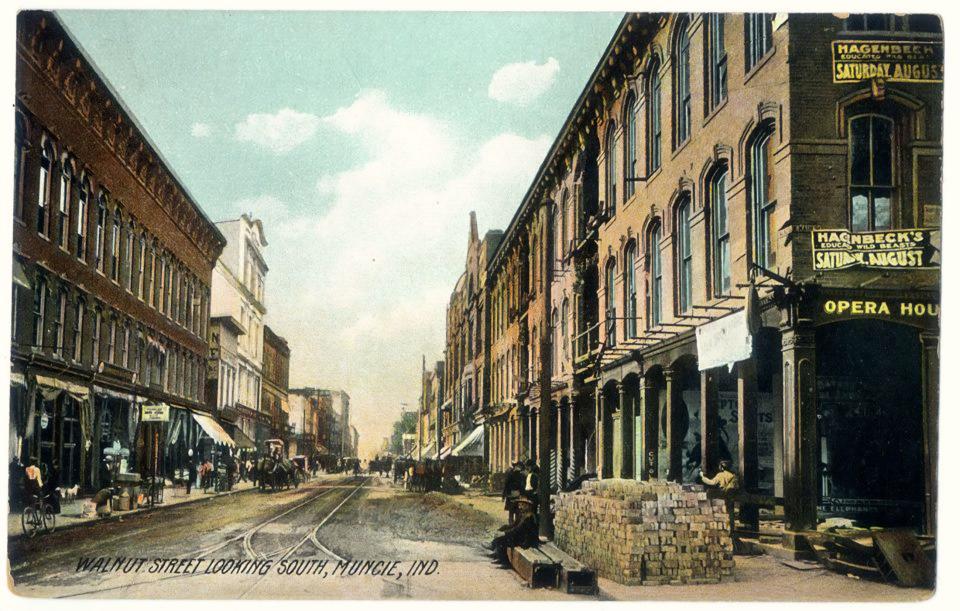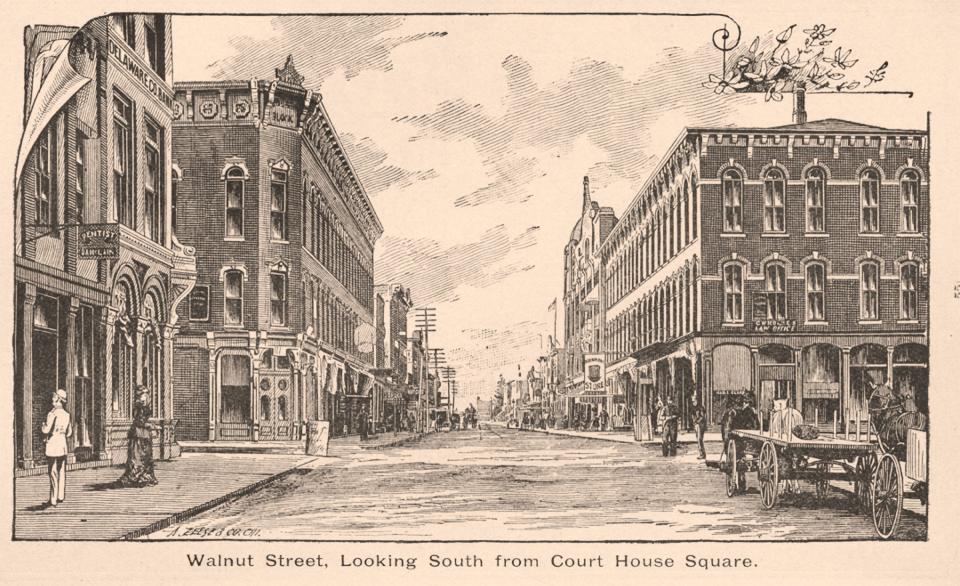ByGone Muncie: An accounting of John Ervin’s Opera House Saloon from 1880s
MUNCIE, Ind. – A few weeks ago, Scott Albertson, a driver with the Muncie Sanitary District, stopped by the historical society with a legit treasure. Albertson had an old invoice ledger from a Muncie business that he wanted to know more about.
The book’s original owner was John R. Ervin, a Civil War veteran who ran a popular saloon, liquor wholesale, and billiards hall in the Wysor Opera House building from 1879 until his death in 1896. The ledger is in excellent condition and shows paid invoices between June 25, 1885 and March 20, 1888.

Unlike the debauchery commonly found at disreputable Muncie saloons, Ervin’s joint was a respectable place in the 1880s. The Morning News gushed in November 1881 that Ervin ran “a well furnished, handsomely equipped and well conducted liquor house, where gentlemen can resort for refreshments, with assurance of being supplied with pure liquors, of good quality, secure from the insults and crowding of loafing bullies and bummers.”
The saloon was located in prime downtown real estate, the 1873 Wysor Opera House building at the southwest corner of Main and Walnut streets. The Wysor’s front entrance was on Main but several storefronts ran along the side facing Walnut. Some of this space was leased in 1876 to Charles Russey for a saloon. It remained as such, though under different owners, until 1905 when the Wysor Building replaced the Wysor Opera House.
John Ervin was the longest owner of the saloon. He was born in 1842 just across the Randolph County border in Windsor. He moved to Muncie as a teenager and found work in Samuel Brady’s harness shop. When the Civil War broke out, Ervin volunteered and served in the Union Army’s 36th Indiana Infantry Regiment. He fought in the battles of Shiloh, Chickamauga, and Mission Ridge. Early in the war, he was captured after the Battle of Stones River and held in a Confederate prison camp for a few months. In late 1864, he marched with Sherman to the sea, smashing the rebel-held countryside in the process.
Ervin returned to Muncie after the war and managed a saloon in the Neely Building on East Main. He moved briefly to Missouri in 1872 and worked as a grocer but returned to Muncie in '79 and bought the Opera House Saloon from Russey. Under Ervin, the saloon “had undergone a complete and magnificent transformation,” according to the Morning News.
The saloon now featured a marble and slate floor, an ornately designed ceiling of lavender colored tiles, an enormous chandelier, and gold molding. A sign descended from the ceiling that read ERVIN’S in all caps. Wood panels and artwork adorned the walls, along with a giant 11x15 foot mirror that hung at one end. A custom-designed cooler of black walnut and ebony kept the beer frosty cold, courtesy of Muncie Ice.
For well-to-do Munsonians, the Opera House Saloon was the place to go in the ‘80s. The Daily Times reported that Ervin sold 200 kegs of beer in August 1880 alone. The following year he added a billiards room and a wholesale liquor and cigar store. The Morning News remarked that Ervin’s sample room “is undoubtedly the finest in the State of Indiana outside of Indianapolis.”
John Ervin started using the ledger in the summer of 1885. The first entry on June 25 shows that he paid $127.20 for 2,100 Cuban cigars from P.C. Fulweiler Cigar Manufacturer in Philadelphia. A few weeks later, he bought 20 kegs of “wiener beer” from C.F. Schmidt Brewers in Indianapolis for $42.50. The ledger contains a total of 26 similar Schmidt Brewing invoices. Wiener beer was quite popular in Muncie at the time. A Morning News ad bragged that it was sold “only at Opera House and Tremont saloons.”
As to be expected from a Gilded Age saloon, the ledger shows that Ervin bought enormous quantities of booze and cigars, mostly from vendors in Indianapolis, Philadelphia, Cincinnati, and Louisville. However, the book also lists transactions with local businesses. For instance on July 6, 1885, Ervin paid Muncie Ice $17.63 for 7,050 pounds of northern Indiana lake ice in the month of June. A week later, he bought 83 lbs of crackers for $4.77 from Joseph Hummel and Son Bakery on 147 E. Main Street. The ledger also has invoices showing routine payments to the publishers of the Muncie Daily Herald, the Sunday Pink, and the Muncie Times for newspaper ads.

In August of 1885, Ervin bought a $6.40 bird cage from Charles Mayer and Company in Chicago. The enclosure was the new home for the saloon’s pet parrot. The year before, the Morning News had written that “John Ervin’s parrot is becoming well versed in the use of words and is quite an attraction to those who call at his place of business.”
For a reason I can’t determine, Ervin paid the architect Brentwood Tolan $28 for “drawings and specifications” just before Christmas in 1885. The invoice provides no other details, but I’m guessing Ervin bought copies of architectural drawings for the planned third Delaware County Courthouse. Ervin was listed in the press earlier that year as a holder of county courthouse bonds.
A year later, Ervin electrified his Opera House Saloon, paying James Boyce $30.80 in January for his company to install electric “lamps and fixtures.” His electric bill for the month of March 1886 was $9.30. After natural gas was discovered, Ervin paid the newly formed Muncie Natural Gas Company $10.96 to add service to his saloon. His gas bill for April 1887 was $3.
In addition to running the saloon, Ervin was active in the Benevolent and Protective Order of Elks and the Williams Post of the Grand Army of the Republic, a veterans organization. On March 7, 1883, he married Maggie Brady, the Kirby Hotel’s housekeeper. The couple had one child, a son named John. The family attended St. Lawrence Catholic Church.
In May of 1896, John Ervin fell ill and died young at the age of 54. His obit suggested that what caused his death stemmed from old war wounds. Nathan Long of Muncie’s GAR remarked that “again has death claimed as a victim a veteran of the war. John R. Ervin … has gone to his eternal bivouac after months of suffering caused by wounds from rebel shot and shell, and exposure to southern sun and storm.”
In life, I’m sure Ervin kept other business ledgers, but I have no idea how or why this one survived 135 years. Ervin probably didn’t think much of it. At the time, it was nothing more than a banal accounting of his invoices. But for us, five generations later, it offers detailed insight into a very different Muncie of long ago.
Chris Flook is a Delaware County Historical Society board member and a Senior Lecturer of Media at Ball State University.
This article originally appeared on Lafayette Journal & Courier: ByGone Muncie: An 1880s ledger from John Ervin’s Opera House Saloon
